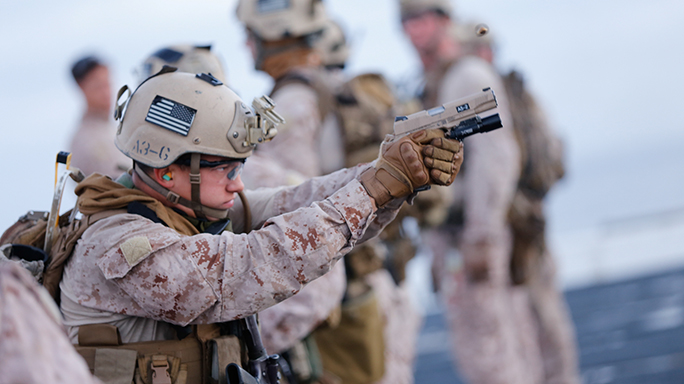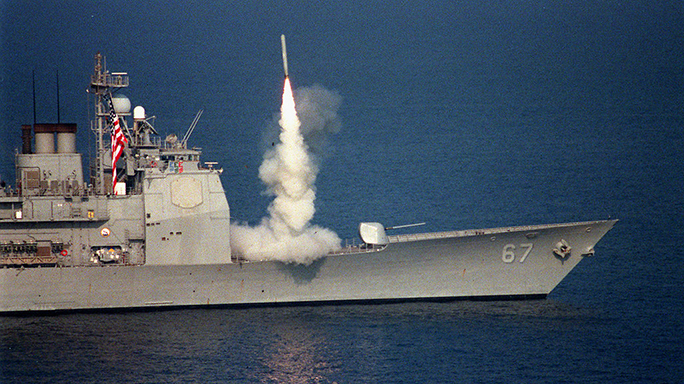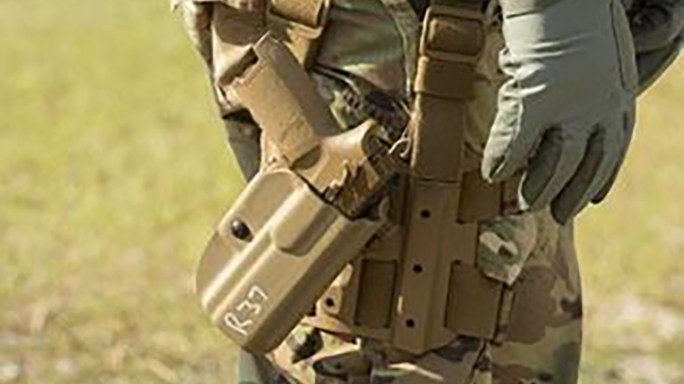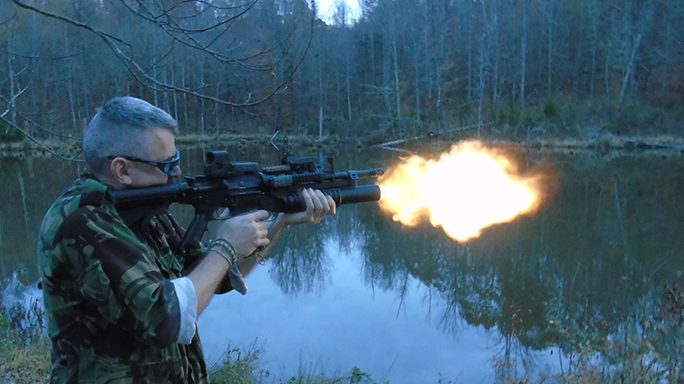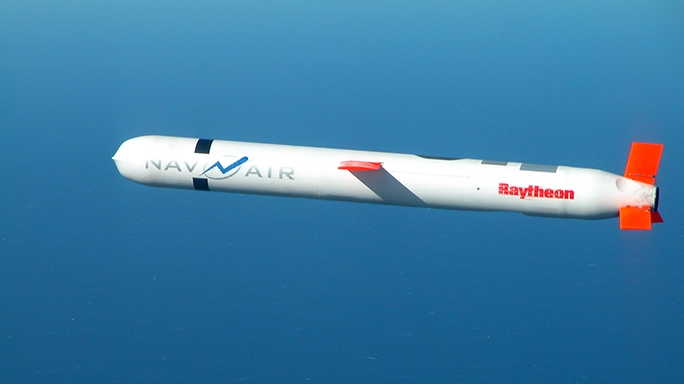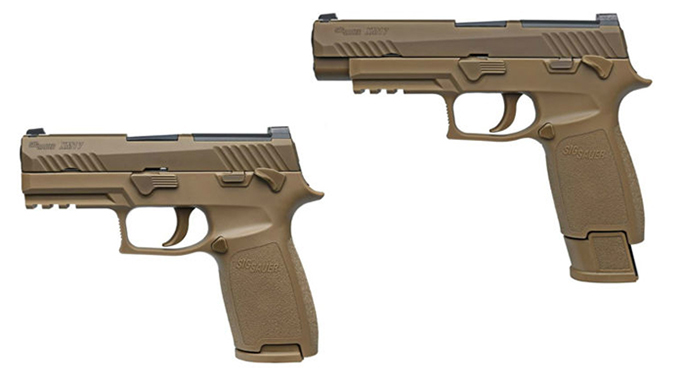Examining the combat handgun needs context. Real-life is usually a good start.
On Sept. 25, 1993, a former co-worker of mine named Dale Shrader was piloting a UH60 Blackhawk helicopter under night vision goggles just above the rooftops in Mogadishu, Somalia. The sordid events described in the book “Black Hawk Down” would occur a mere six days later.
Advertisement — Continue Reading Below
Dale’s Blackhawk was hit suddenly and unexpectedly in the fuselage by an RPG antitank rocket. The aircraft caught fire immediately. Dale managed a controlled crash into downtown Mogue. The aircraft skidded fully 100 meters before coming to rest.
Dale and Perry Alliman, his fellow pilot, barely escaped the burning wreck with multiple broken bones and severe burns. Their other three crew members succumbed to the flames despite Dale’s best efforts to rescue them.
The most striking aspect of the story, to my recollection, was how shockingly unexpected it had been. One moment you are tearing across the cityscape in a high performance combat aircraft — familiar, safe, and comfortable. The very next, you are grievously injured and otherwise alone in hostile territory surrounded by armed militia intent on killing you.
Advertisement — Continue Reading Below
Perry was so badly injured as to be combat ineffective. Dale had a broken wrist and severe burns, but he could move under his own steam. Between them they had two M9 9mm pistols and a pair of survival knives. For whatever reason, neither of their survival radios was operational. It was pitch dark and the Somalis were hunting them.
Dale fought off the probing Somalis armed with Kalashnikovs and hand grenades for nearly an hour with nothing more than these two handguns, killing at least one enemy combatant in the process. When the situation seemed most dire and their ammunition was expended, Dale and Perry readied themselves for death.
Suddenly, an unidentified young Somali emerged from the darkness. He led them to an armored personnel carrier crewed by soldiers from the United Arab Emirates. They were safe.
Advertisement — Continue Reading Below
Dale’s story is one of tremendous courage and bold faith. He makes a compelling argument that the young Somali was divinely sent. Both Dale and Perry have subsequently devoted their lives to sharing their common Christian faith so galvanized by their ordeal in Somalia. While these two brave soldiers are alive today because of divine providence and their utter refusal to quit, theirs is also a compelling tale concerning the importance of the combat handgun, even in the Information Age.
Cost Perspective
A single sea-launched Tomahawk cruise missile cost the government about $1.5 million in 2017. These autonomous subsonic weapons are produced by Raytheon and allow commanders the luxury of attacking heavily defended targets without having to put American lives at risk. As a former soldier myself, we all had the deepest unflagging affection for cruise missiles.
Advertisement — Continue Reading Below
Scuttlebutt has it that SIG Sauer will get a mere $207 for each new P320 M17 modular handgun it sells the government. Don’t lose any sleep that SIG might somehow suffer from this, however. For every M17 they sell Uncle Sam they will unload half a dozen at a proper price to geeks like me who simply must have one of our own. SIG should do just fine.
That means the government could buy 7,246 M17 handguns for the cost of a single Tomahawk cruise missile. In the 21st century, the humble handgun is a phenomenally cost-effective weapon system. As Dale and Perry can attest, it is also one of the most important.
Combat Handgun Historical Cred
The military sidearm has gravitas beyond its simple applicability on the battlefield. Artillery, close air support and smart weapons — like the Tomahawk, JDAMs and Hellfire — spill way more blood. However, the handgun also serves as a badge of authority and security blanket for troops in harm’s way.
Advertisement — Continue Reading Below
The primary strength of the military handgun is not its effectiveness or its lethality. It is, rather, its simple portability. When I served and was away from garrison I was never without my handgun. No matter the uniform, circumstances or environment, that M9 was always on my person.
In previous eras, the guy with the pistol was the one you shot first. A combat handgun, be it a P08 Luger, a Walther P38, a Tokarev TT33, or a Colt 1911A1, marked its wielder as one in authority and worthy of extra attention on the battlefield. In recent times, however, that has begun to change.
Since World War I, the U.S. military has used the handgun to arm second line troops such as mortarmen and communications specialists for whom a bulky combat rifle might be an impediment. The M1 carbine was a remarkably prescient effort at providing a more effective combat implement, which ultimately evolved into the M4 that so pervasively arms American soldiers today. Throughout it all, however, there always remained a place for the pistol.
Advertisement — Continue Reading Below
Cogitations
Soldiers in Vietnam frequently arranged their 1911 pistols over the crotch as a sort of codpiece to help protect the family jewels. A friend and decorated infantry officer from the Korean War owes his life to the 1911 he carried in a shoulder holster that deflected a communist sniper’s bullet otherwise destined for his heart. Nowadays the combat handgun sees wide distribution for a broad variety of reasons.
The British Ministry of Defence now equips all of its soldiers serving downrange with a Glock handgun. Today’s combat pistols are lightweight, utterly reliable and relatively inexpensive. I feel it is a safe bet that we will see handguns as part of the standard combat loadout for most of our warriors for the foreseeable future.
I slept with mine in my sleeping bag. Dale, Perry and my friend from Korea owe their lives to the handguns they were issued. Once Dale came back from Somalia he became an enthusiastic apostle for both Jesus and proper range time with your primary weapon.
Advertisement — Continue Reading Below
In a combat environment populated by stealth aircraft, autonomous smart weapons and North Korean nukes, there yet remains more impetus than ever for a quality combat handgun with which to arm American service men and women. In the SIG Sauer M17, we have a state of the art weapon that should soldier on for generations.
